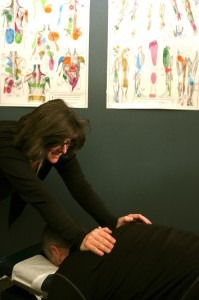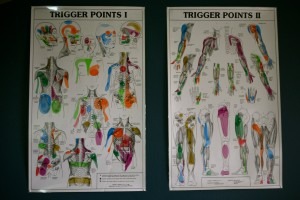Chiropractic Techniques
- At In Line Chiropractic, we use an adjusting style commonly referred to as “Diversified.”
- First, an analysis of your spine is performed. This can initially involve a case history.
- A special hand arrangement called a “pisiform contact” is used to deliver a specific thrust at the right place and the right time.
- Subsequent visits may include motion palpation, with the chiropractor feeling the spinal joints move as you turn and bend. Or, a leg check may be performed, to uncover an imbalance in the neck or lower spine.
- With the malposition of one or more spinal bones identified, a specific manual thrust is administered. The direction, speed, depth and angle that are used is the result of years of experience, practice and a thorough understanding of spinal mechanics.
- The energy delivered during the thrust may produce a slight “popping” sound from the shifting of gas and fluids in the joint. This sound may be interesting, but is not a guide as to the value or effectiveness of the adjustment.
- While improving spinal biomechanics can reduce nervous system interferences, virtually all joints of the body can be adjusted to help restore proper range of motion.
Activator
- The Activator Methods® Adjusting Instrument is a handheld spring-loaded tool that delivers a consistent low-force, high-speed thrust.
- Because it’s many times faster than adjustments delivered by hand, the body rarely tightens to resist, making adjustments comfortable and effective. It’s also helpful for adjusting elbows, wrists, knees and other joints of the body.
Thompson Drop Technique
- The Thompson Technique is another method of adjustment that involves analyzing the length of the legs. This technique uses a ‘drop table’ for adjustment, where a gentle thrust is applied to the joints, which in turn, sets the drop piece into motion and targets the specific joint or tissue. After completing a leg check analysis, your chiropractor will determine the type of misalignment.
- The “Segmental Drop System” takes advantage of the spine’s inherent design of the joints in order to move the spinal segment in the direction that will improve the motion of the segment with the one above and below. The majority of spinal adjusting done utilizing the Thompson Technique has the patient lying prone (face down).
- The drop mechanism of the table also allows for easier manipulation of most of the joints in the body, as well as the extremities, ribs, TMJ and clavicle adjustments.
- There is usually no “popping or cracking” with a Thompson Drop Table Adjustment.
SOT Blocking
- Using padded wedges to treat mechanical dysfunction of the pelvis is a technique procedure that is practically synonymous with Sacro-Occipital technique (SOT). Although we are not surprised at this, given that it was SOT founder Major DeJarnette, DC who popularized what he termed pelvic “blocking” procedures, there is no reason to limit how we use these wedges (or blocks). DeJarnette primarily employed blocks to correct pelvic torsion, whereas we use them to correct pelvic and other postural faults and clinical conditions.
- Addressing pelvic torsion entails laying the patient across the blocks in either the prone or supine position with the blocks oriented diagonally
- Myofascial Release is a safe and very effective hands-on technique that involves applying gentle sustained pressure into the Myofascial connective tissue restrictions to eliminate pain and restore motion. Each Myofascial Release Treatment session is performed directly on skin without oils, creams or machinery. This enables the therapist to accurately detect fascial restrictions and apply the appropriate amount of sustained pressure to facilitate release of the fascia.
- Myofascial pain syndrome (MPS) is a fancy way to describe muscle pain. It refers to pain and inflammation in the body’s soft tissues.
- Myofascial pain may develop from a muscle injury or from excessive strain on a particular muscle or muscle group, ligament or tendon. It is a chronic condition that affects the fascia (connective tissue that covers the muscles). Myofascial pain syndrome may involve either a single muscle or a muscle group. Sometimes the area where a person experiences the pain may not be where the myofascial pain generator is located. The actual site of the injury or strain can prompt the development of a “trigger” or “tender” point which causes pain in other areas. This is known as referred pain. Other causes of myofascial pain may include:
- Injury to intervertebral disc
- General fatigue
- Repetitive motions
- Medical conditions (including heart attack, stomach irritation)
- Lack of activity (such as a broken arm in a sling)
Kineseo Taping
- Is a method of taping used to help heal injured areas by providing support and stabilization to injured areas. Kinesio tape is used on Olympians and professional athletes alike. This specially designed tape allows patients to move and function with just enough support to help them heal and get through whatever activity they are involved in.
If you’ve been to a chiropractor before and prefer to be adjusted in a particular way, let Dr. Bissonette know. We want you to relax, enjoy and fully benefit from your chiropractic care.
Dr. Shanna Bissonette, DC, is a chiropractor in Mammoth Lakes and has a satellite office in Bishop. She treats patients with acute and chronic pain presentations, headaches, neck and lower back pain regularly. Her healthcare approach is to focus on the musculoskeletal and nervous system and the effects of these disorders on general health.


